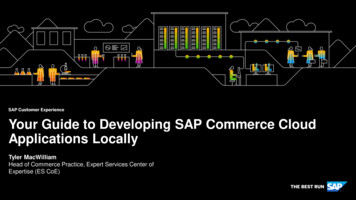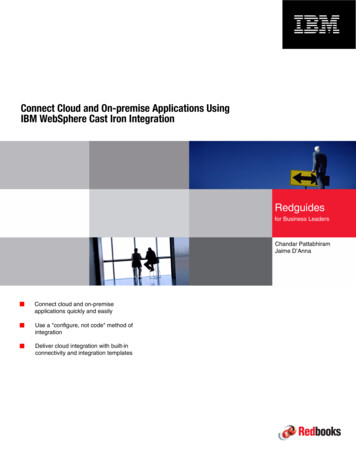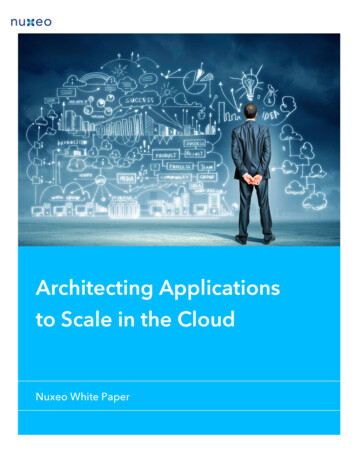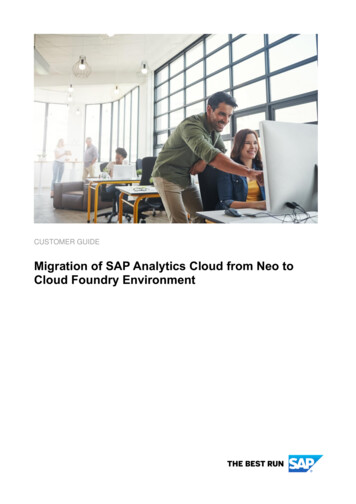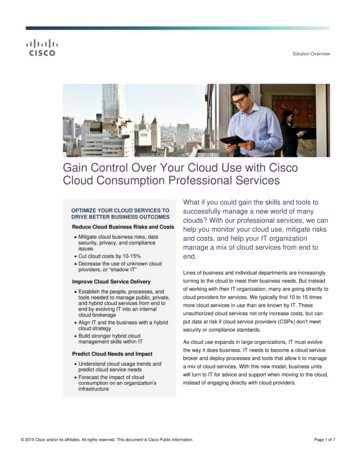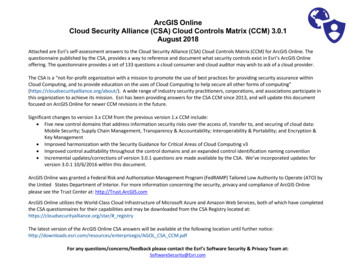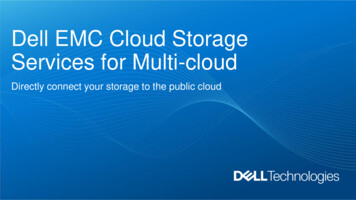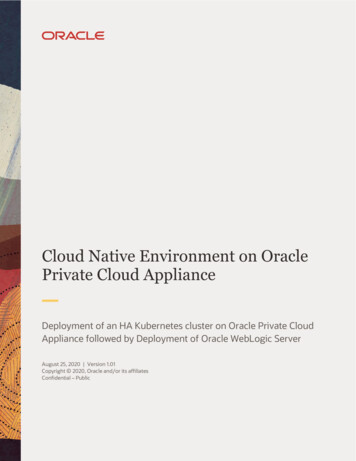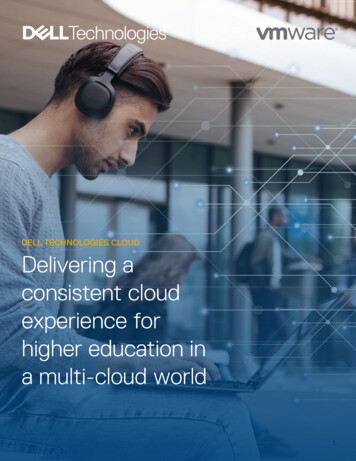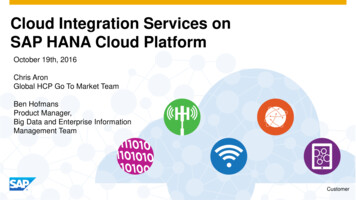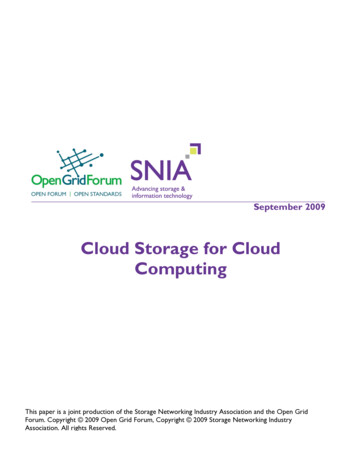
Transcription
The Making of Cloud Applications – An Empirical Study onSoftware Development for the CloudJürgen Cito, Philipp Leitner, Thomas Fritz, Harald GallUniversity of Zurich, SwitzerlandarXiv:1409.6502v2 [cs.SE] 17 Mar 2015{lastname}@ifi.uzh.chABSTRACTCloud computing is gaining more and more traction as a deployment and provisioning model for software. While a largebody of research already covers how to optimally operate acloud system, we still lack insights into how professional software engineers actually use clouds, and how the cloud impacts development practices. This paper reports on the firstsystematic study on how software developers build applications in the cloud. We conducted a mixed-method study,consisting of qualitative interviews of 25 professional developers and a quantitative survey with 294 responses. Ourresults show that adopting the cloud has a profound impactthroughout the software development process, as well as onhow developers utilize tools and data in their daily work.Among other things, we found that (1) developers need better means to anticipate runtime problems and rigorously define metrics for improved fault localization and (2) the cloudoffers an abundance of operational data, however, developers still often rely on their experience and intuition ratherthan utilizing metrics. From our findings, we extracted a setof guidelines for cloud development and identified challengesfor researchers and tool vendors.1.INTRODUCTIONSince its emergence, the cloud has been a rapidly growing area of interest [1, 2]. Several cloud platforms, such asAmazon’s EC2, Microsoft Azure, Google’s App Engine, orIBM’s Bluemix, are already gaining mainstream adoption.Developing applications on top of cloud services is becomingcommon practice. Due to the cloud’s flexible provisioningof resources, and the ease of offering services online for anyone, the cloud also influences software development practices. For instance, cloud development is often associatedwith the concept of “DevOps”, which promotes the convergence of the development and operation of applications [3].There is currently significant research interest in how to efficiently manage cloud infrastructures, for instance in termsof energy efficiency [4] or maximized server utilization [5].Permission to make digital or hard copies of all or part of this work forpersonal or classroom use is granted without fee provided that copies arenot made or distributed for profit or commercial advantage and that copiesbear this notice and the full citation on the first page. To copy otherwise, torepublish, to post on servers or to redistribute to lists, requires prior specificpermission and/or a fee.Copyright 20XX ACM X-XXXXX-XX-X/XX/XX . 15.00.Another core area of interest in cloud computing research isits use for high-performance computing in lieu of an expensive computer grid [6]. However, so far, there is little systematic research on the consumer side of cloud computing,i.e., how software developers actually develop applicationsin and for the cloud. Only recently, Barker et al. voicedthis concern in a position paper, stating that the academiccommunity ought to conduct more “user-driven research” [7].In this vein, this paper presents a systematic study onhow professional software engineers develop applications ontop of cloud infrastructures or platforms. We deliberatelycover a broad scope, and analyze how applications are designed, built and deployed, as well as what technical tools areused for cloud development. We conducted a mixed-methodstudy consisting of an initial interview study with 16 professional cloud developers, a quantitative survey with 294respondents, and a second round of interviews with 9 additional professionals to dive deeper into some questions raisedby the survey. All interview participants work at international companies of widely varying size (from small start-upsto large enterprises), and have diverse backgrounds with professional experience ranging from 3 to 23 years.In particular, we addressed the following two researchquestions:RQ 1: How does the development and operation of applications change in a cloud environment?In the cloud, servers are volatile. They are regularly terminated and re-created, often without direct influence of thecloud developer. Our study has shown that the concept ofAPI-driven infrastructure-at-scale and this cloud instancevolatility have ripple effects throughout the entire application development and operations process. They restrict thedesign of cloud applications and force developers to heavily rely on infrastructure automation, log management, andmetrics centralization. While these concepts are also usefulin non-cloud environments, they are mandatory for successful application development and operation in the cloud.RQ 2: What kind of tools and data do developers utilizefor building cloud software?Based on our research, more data, and more types of data,are utilized in the cloud, for instance business metrics (e.g.,conversion rates) in addition to system-level data (e.g., CPUutilization). However, developers struggle to directly interpret and make use of this additional data, as current metricsare often not actionable for them. Similarly, cloud developers are in the abstract aware that their design and implementation decisions have monetary consequences, but in
their daily work, they do not currently think much aboutthe costs of operating their application in the cloud.Our research has important implications for cloud developers, researchers, and vendors of cloud-related tooling. Primarily, due to the volatility of cloud instances, developersneed to accustom themselves to not being able to directlytouch the running application any longer. That is, quickfixes of production configuration are equally impossible aslogging into a server for debugging. As a research community, we need to investigate how to best support developers in this task, as well as analyze how code artefactsrelated to cloud instance management evolve. Finally, wehave seen that more types of metrics get more and moreimportant, but they are still not directly actionable for developers. Hence, we need to research better tooling thatbrings this data into the daily workflow of cloud developers.The remainder of the paper is structured as follows. First,we provide some background on cloud computing terminology (Section 2), followed by a discussion of related work inSection 3. We then present the study design (Section 4),followed by an in-depth summary of our findings (Section 5)and a discussion of the implications resulting from thosefindings (Section 6). We detail the major threats to validity of our research in Section 7, and conclude the paper inSection 8.2.BACKGROUNDWhile the term “cloud computing” is commonly ill-defined1 ,the research community has widely gravitated towards theNIST definition [8]. As illustrated in Figure 1, this definition considers three levels, each defined by the responsibilities of IT operations provided by the cloud vendor. Inan Infrastructure-as-a-Service (IaaS) cloud, resources (e.g,computing power, storage, networking) are acquired and released dynamically, typically in the form of virtual machines.IaaS customers do not need to operate physical servers, butare still required to administer their virtual servers, andmanage installed software. Platform-as-a-Service (PaaS)clouds represent a higher level of abstraction, and provideentire application runtimes as a service. The PaaS providermanages the hosting environment, and customers only submit their application bundles. They typically do not haveaccess to the physical or virtual servers on which the applications are running. Finally, in Software-as-a-Service (SaaS),complete applications are provided as cloud services to endcustomers. The entire stack, including the application, ishandled by the provider. The client is only a user of theservice.PaaS clouds are particularly interesting for software engineers, as they allow them to solely focus on developingsoftware applications. They typically relieve the developerfrom having to care about any operations tasks, and handle varying system load transparently via auto-scaling. Thisability to adapt to workload changes is referred to as elasticity. However, in order to do so, these platforms imposesevere restrictions. For instance, they typically only supportrather narrowly defined application models (e.g., three-tierWeb applications), and require the developer to programagainst provided APIs. This often also leads to vendor lockin [9].1Oracle’s CEO Larry Ellison once noted jokingly that hecannot think of a single thing Oracle does that is not aApplicationSaaSDataApplication RuntimeApplication onDataApplication onVirtualizationHardwareHardwareHardwareManaged by ClientManaged by Cloud VendorHigher AbstractionFigure 1: Basic models of cloud computing (following [8])With IaaS, the idea of Infrastructure-as-Code (IaC) hasalso started to gain momentum. IaC allows users to defineand provision operation environments in version-controlledsource code. Essentially, in an IaC project, the entire runtime environment of the application (e.g., IaaS resources,required software packages, configuration) is defined usingscripts, which can then be executed by tools such as OpscodeChef2 . These scripts allow entire test, staging or productionenvironments to be started without manual interaction. Themove towards IaC with its reproducible provisioning has become necessary since cloud applications often consist of alarge number of machines that have to be configured automatically to scale horizontally.Another concept commonly associated with cloud development is DevOps [3]. DevOps describes the convergenceof the previously mostly separated tasks of developing anapplication, and its deployment and operation. In DevOps,software development and operation activities are often handled by the same team, or even by the same engineer. Byaligning the goals of development and operations, DevOpsaims at improving agility and cooperation.3.RELATED WORKThere has been a multitude of empirical research on thedevelopment of general software applications. For instance,Singer et al. have recently researched how developers useTwitter [10]. Murphy-Hill et al. have looked at how bugsare fixed [11]. However, so far, very little empirical researchhas been conducted in the cloud computing domain, eventhough there are several calls for more research on software development for the cloud. Barker et al. [7] recentlynamed “user-driven research” as one of the major opportunities for high-impact cloud research. Khajeh-Hosseini etal. [12] stated that the organizational and process-orientedchanges implied by adopting the cloud is currently not sufficiently researched. While Mei et al. did not consider software engineering a major challenge for cloud computing in2008 [13], they later on provided a whole list of softwareengineering issues to be tackled by research [14].So far, research in cloud computing has mainly focused onprovider-side issues (e.g., relating to server management [4,5] or performance measurement [6]). On the client side, someresearch has been conducted on concrete programming mod2https://www.getchef.com
els. A large part of this research deals with data analysis,typically using the Map/Reduce paradigm (e.g., [15]). Whileinteresting, these works do not cover the professional software development environment that we address with ourstudy. Research on cloud programming models for nonscientific contexts is more limited. One example is the jCloudScale framework proposed in [16]. jCloudScale is a Javabased middleware that aims to simplify the development ofIaaS applications. A similar goal also motivated the researchpresented in [17], which investigated an extension of JavaRMI for simplifying the development of elastic, cloud-basedapplications.One aspect that is already reasonably well-understood inliterature is how and when companies choose to adopt cloudcomputing, and for which reasons. A large-scale survey onthis topic has been presented in [18]. The authors concludethat improved business agility is a larger factor for companies to adopt the cloud than reduced costs. In a secondstudy on cloud adoption in small and medium-sized enterprises [19], the authors conclude that ease of use and convenience is a more important reason for adoption than both,reduced costs and improved business agility. However, bothof these studies are concerned primarily with SaaS adoption.That is, they target cloud adoption by end users more thanby professional software developers. This is not the case ina related industry study, dubbed the “DevOps Report” [20].This survey garnered over 9200 respondents, praising theDevOps idea as a key enabler of profitable and agile companies. Given that the source of this report is also a majorplayer in the DevOps business, independent scientific evaluation to support these results would be valuable.None of the work discussed so far has empirically evaluated how cloud software is actually developed in practice.The only work we are aware of that goes into this directionis a (not peer-reviewed) white paper on enterprise softwaredevelopment in the cloud [21]. This report is based on asurvey with 408 respondents. The report concludes that enterprise developers are largely not yet adopting the cloud,but if they do, they are able to improve time-to-market.4.RESEARCH METHODTo investigate how the cloud influences software development practices, we conducted a study based on techniquesfound in Grounded Theory [22]. Following the recommendations in [23], we used a mixed methodology consisting ofthree steps of data collection and iterative phases of dataanalysis. First, we defined a set of open-ended questionsfrom our research questions and condu
tional professionals to dive deeper into some questions raised by the survey. All interview participants work at interna-tional companies of widely varying size (from small start-ups to large enterprises), and have diverse backgrounds with pro-fessional experience ranging from 3 to 23 years. In particular, we addressed the following two research questions: RQ 1: How does the development and .

